|
|
|
The Rugby works of the British Thomson-Houston company started as a small enterprise, but soon grew to colossal proportions as one of the largest industrial sites in the entire British Empire. Lamps, of course, formed just a small part of the company's success which stretched across the entire spectrum of electrical appliances right up to enormous machines such as steam turbines, the first jet engines, power generation plant and diesel-electric locomotives. Rugby's heart was deeply entrenched in the heavy electrical business and after five decades the small corner involved in lampmaking was reloacted to join the company's other lamp factories, thereby allowing Rugby to concentrate on large electrical machines.
|

General View of BTH Rugby Works, 1914. The Incandescent Lamp Factory buildings are highlighted in colour.
|
| Address |
Leicester Road, Rugby, Warwickshire, United Kingdom |
| Location |
Building 1
Building 2
Building 15
Building 78 |
| Opened |
1902 |
| Closed |
Lampmaking ended 1958. Remaining site still operational. |
| Products |
Incandescent carbon filament, tungsten filament, projectors, miniature, automotive, fluorescent, mercury vapour, sodium vapour. |
Early History
The origin of the British operations of the company can be traced back to 1886 when its American parent, the Thomson-Houston Electric Company, established the London firm Laing, Wharton & Down to act as its agents for the sale of the company's American-made electrical goods. In addition electricity meters were imported from La Compagnie des Compteurs of Paris, which was also associated with T-H and later became the French Thomson-Houston Company. In 1889 the British operations were re-named the Laing, Wharton & Down Construction Syndicate Ltd. Around this time, the first imports of both arc and incandescent lighting systems from T-H of America began.
Shortly afterwards in 1892 the Thomson-Houston company was merged with the Edison Electric Company to form the General Electric Company of USA. Edison also had operations in Britian, the most significant of which was the Ediswan lamp works at Ponders End. From this moment onwards, both the Ediswan operations as well as Laing, Wharton & Down shared the same parent company in GE of America.
In 1894 a new company was created with £1 million in capital from both British and French bankers, plus a loan of a further £0.75 million from GE of America, to further grow the success of importing American electrical goods into Britain. It was named British Thomson-Houston Limited and purchased the exclusive UK rights to all products of GE of America. In May 1896 it was re-named with the slightly grander-sounding title of "The British Thomson-Houston Company Limited". It at once became known around the globe as BTH. This new company could not adopt the same name of General Electric as its American parent, because there already existed the similarly-named but unrelated General Electric Company of England.
The company prospered quickly, and by 1899 it was clear that there would be tremendous advantages in the establishment of manufacturing in Britain. In January 1900 a 25 acre site known as Glebe Farm was identified in the town of Rugby, which was chosen because of its central location in Britain, the close proximity of the River Avon to provide cooling for the manufacturing operations, and the important intersection of the site by two main railway lines. It was purchased from a Mr. Thomas Hunter, builder of railway wagons, for £10,000. Levelling works began on 11th January 1900, with construction of the first buildings a few months later. Fourteen steel and brick buildings were planned for the initial phase, with a floor area of 206,230 square feet to house about 800 workers. These would begin manufacture of the electricity meters which BTH had previously imported from FTH, along with the carbon filament lamps, motors, alternators, steam turbines, switchgear and transformers that had until then been sourced from GE. Manufacturing began on 14th March 1902. The fact that BTH enjoyed full rights to make use of GE's patents at once put it in an extremely powerful position among the already existing British electrical manufacturers. |
The Lamp Factories
The original lampworks was one of the first buildings to be constructed at Rugby, during the period 1900-1902. It was housed in Building 2 at the South-Eastern corner of the site, close to Building 1 which was originally a small shed to store patterns for the iron foundry.
By 1905 the site had expanded tremendously and more room was required for lampmaking. Building 1 was taken over by the Lampworks and extended southwards, to about four times its original size. The original part of Building 1 can be seen in the main illustration above, where a rooftop delineation separates this area from the much larger extension. Building 2 had also been extended, mainly southwards but also by a small amount to the north, thus making it similar in size to the adjacent extended Building 1. A third lampworks, Building 15 was also constructed, at the far South-Eastern boundary of the site.
1910 saw the start of tungsten lamp manufacture at Rugby, initially with squirted tungsten filaments, and still more space was required. By 1914 Buildings 1 and 15 had been extended further southwards, right down to the permiter of the site, which prevented any possible further extension of those buildings. The general view at the top of this page shows the site at this time, with the lampmaking factories, from left to right, being Buildings 2, 1 and 15 respectively.
Incidentally it was feared at this time that Rugby would not be able to construct new buildings rapidly enough to follow the expected boom in manufacture of tungsten lamps, and in 1912 a purpose-built lamp works was erected at Willesden in London, to help the company meet its demand. However by the time it was finished, the original squirted filament tungsten lamp was already obsolete and had been superseded by the much superior lamps having drawn wire tungsten filaments. These were considerably easier to manufacture and Rugby was able to handle the entire demand itself. Willesden was thus never used as a lampworks, and instead the similarly-growing switchgear division was relocated there.
Prior to 1914, Building 25A was constructed in the area in front of Building 2 and some recent references state that lamps were also produced there, although this seems unlikely since it was an extention of Building 25, the Control Gear Factory. Certainly in much later years once Building 2 had been demolished the adjacent Building 25A was further extended to cover the entire area formerly occupied by Building 2, so it is true to say that the physical location of Building 25A was used for lampmaking, but it was instead in the earlier Building 2 at that site.
Meanwhile, developements were taking place in the Research Laboratory on sodium and mercury vapour lamps, and there was no space available when these developments were ready for transfer to the factory. In 1933 alone more than a thousand 400-watt MA mercury lamps had to be manufactured in the cramped conditions of the research lab itself. In 1935 work started on a vast new Lamp Works, Building 78. It marked the first major extension to the West beyond Black Path, a coke-lined footpath that intersects the site. References state that this was built to house the sodium and mercury lamp production, however on account of its vast size, it is believed that some of the incandescent or automotive production must also have been transferred to Building 78. It was a single storey building of 100,000 square feet, which was completed and became operational in 1936.
During the second world war the Rugby works was called on to commence manufacture of many supplies for the armed forces as well as a general increase in output for all of its existing products. Part of the original lamp works had to be cleared to create space for the manufacture of ammunition shells, and during 1940-46 Building 78 was extended northwards to provide an additional 30,000 square feet for lampmaking.
|
Decentralisation of Lampmaking
Until the 1940s, the vast majority of BTH products had been manufactured on the Rugby site which was becoming increasingly crowded. The lampworks by then occupied a considerable floor space, which must have seen like an attractive area for expansion to some of the departments engaged in heavy electrical goods. The end of the Second World War was the trigger which set in motion a programme of decentralisation, which gradually led to the end of lampmaking at Rugby.
In the nearby city of Leicester, BTH had established at Melton Road one of a series of so-called wartime shadow factories. The Leicester factory was engaged in the manufacture of aircraft magnetos, a critical component which prior to the war had been imported from Germany. The main magneto factory was at BTH's Coventry works, and Leicester served as a back-up in case Coventry should have been bombed. After the war demand for such products evaporated virtually overnight, and the Leicester site presented a large, empty, modern building of similar design to Rugby's Building 78 Lampworks. It was also close enough to Rugby to allow easy communication with the Research Laboratory, which by then was playing a critical role in the frequent development of new lamps.
By March 1st 1946, production of both Automotive and Fluorescent lamps had been transferred entirely to Leicester. Soon afterwards the Mercury and Sodium discharge lamps followed. This transition is expected to have freed up almost the entire of Building 78. Some years later in 1958 the decision must have been taken to clear out the remaining lamp production from Rugby. A brand new lamp works was constructed at Trent Vale to house the ordinary high-speed GLS lamp machinery, and the remainder of the special incandescent lamps were transferred to Ponders End. |
Photographs - Tungsten Lamp Department, 1911
While the author of this website was employed at the Leicester lampworks, a small wooden box of glass photographic plates was found in an old cupboard of the Discharge Circuits Laboratory. Contact prints were developed to reveal the positive images, and upon examination it was clear that they pictured the Rugby lampworks. They are believed to date to 1911, the year that Rugby commenced manufacture of drawn tungsten filament lamps, which are prominently featured in many of the images. A few of the photographs clearly show the older squirted tungsten filament lamps still in production, a type which was superseded very rapidly indeed following the start of the much superior drawn tungsten lamp. It is unlikely that the squirted tungsten lamp would have still been in production as late as 1912, so this set of photographs can be dated to 1911 with a high degree of confidence. Some of the slides give away a few details of the architecture of the factory, which makes it possible to identify the exact location as the top floor of Building 15. |
|
 |
|
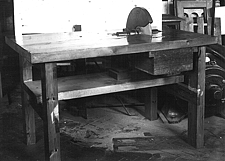 |
|
 |
|
 |
|
| Tube Cutting Machine, Old Style |
|
Tube Cutting Machine, New Style |
|
Hand Flaring Machine |
|
Flare Inspectors Gauges & Scales |
|
|
 |
|
 |
|
 |
|
 |
|
| Leadwire Welders Fire & Tray |
|
Hub Makers Single Fire & Gauge |
|
Hub Makers Inspection Tools |
|
Stem Machine, Rear View |
|
|
 |
|
 |
|
 |
|
 |
|
| Stem M/C, Detail of Spindle & Plates |
|
Stem Inspectors Tools |
|
Stem Repair Table |
|
Stem Department Counter & Racks |
|
|
 |
|
 |
|
 |
|
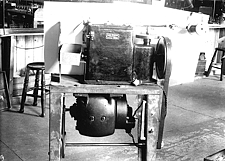 |
|
| Stem Department Racks, 5x4 |
|
Hook Bending Machine |
|
Brückner V-Anchor Bending Machine |
|
Brückner Wire Cutting Machine |
|
|
 |
|
 |
|
 |
|
 |
|
| Loop Twisting Device, General View |
|
Loop Twisting Device |
|
Loop Twisting Device, Detail |
|
Moly Supports Storage Rack |
|
|
 |
|
 |
|
 |
|
 |
|
| Anchorers Shaping Gauge & Tools |
|
Anchorers Guage |
|
Mount Department, General View |
|
Mount Table, Back View |
|
|
 |
|
 |
|
 |
|
 |
|
| Squirted Tungsten Arcing Bottle |
|
Squirted Tungsten Arcing Tweezer+Pin |
|
Squirted Tungsten Arcing Repair Table |
|
Drawn Tungsten, Filament Forming Jig |
|
|
 |
|
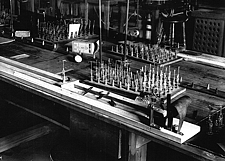 |
|
 |
|
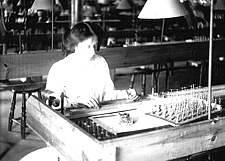 |
|
| Drawn Tungsten, Filament Forming Jig |
|
Drawn Tungsten, Wire Winders Board |
|
Drawn Tungsten, Wire Winders Board |
|
Drawn Tungsten, Winding the Mount |
|
|
 |
|
 |
|
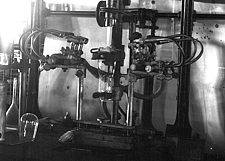 |
|
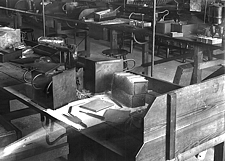 |
|
| Drawn Tungsten, Closing Sleeve |
|
Drawn Tungsten, Inspecting Mount |
|
Bulb Tubulating Machine |
|
Bulb Re-tubulating Repair Table |
|
|
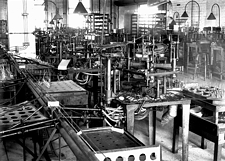 |
|
 |
|
 |
|
 |
|
| Sealing Department, General View |
|
Bulb Sealing Machine |
|
Bulb Sealing Machine, Long Neck |
|
Squirted Tungsten, Arcing Repair |
|
|
 |
|
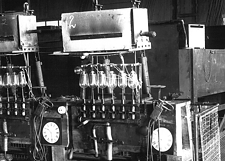 |
|
 |
|
 |
|
| Sintered Tungsten, Re-Arcing Tools |
|
6-Lamp Exhaust Bench, Old Style |
|
6-Lamp Exhaust Heater, Old Style |
|
End View of Exhaust Group, Old Style |
|
|
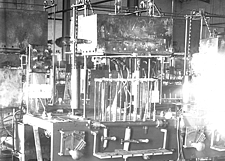 |
|
 |
|
 |
|
 |
|
| 6-Lamp Exhaust Bench, New Style |
|
6-Lamp Exhaust Heater, New Style |
|
6-Lamp Exhaust Bench, Back View |
|
Large Exhaust Heater, Back View |
|
|
 |
|
 |
|
 |
|
 |
|
| Motor on Post, Pump Drive |
|
Motor on Stand, Pump Drive |
|
Rotary Exhaust Pump |
|
Rotary Exhaust Pump, Internal Parts |
|
|
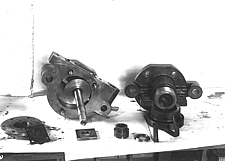 |
|
 |
|
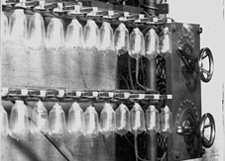 |
|
 |
|
| Rotary Exhaust Pump, View of DuoSeal |
|
McLeod Mercury Vacuum Gauge, Old |
|
Ageing Rack |
|
Ageing Rack Switchboard |
|
|
 |
|
 |
|
 |
|
 |
|
| Tesla Coiling Booth |
|
Wire Lamp Inspecting Block |
|
Basing Machine |
|
Bulb Inspection Windows |
|
|
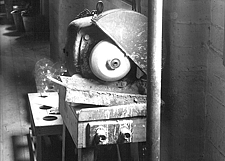 |
|
 |
|
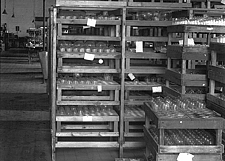 |
|
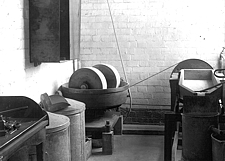 |
|
| Bulb Buffing Wheel & Motor |
|
Lamp Tray Stand |
|
Lamp Sorting Racks |
|
Platinum Recovery Mill + Washer |
|
|
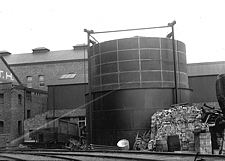 |
|
 |
|
 |
|
| Hydrogen Gas Tank |
|
Salesmen (Good) |
|
Salesmen (Good) |
|
General Views of Rugby Site
|
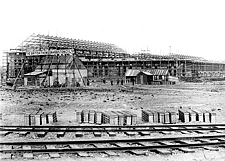 |
|
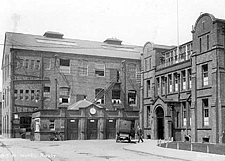 |
|
 |
|
 |
|
| Turbine Factory Construction, 1900 |
|
Main Office Building, 1910 |
|
Main Office Building, c.1915 |
|
Porters' Gatehouse, 1911 |
|
|
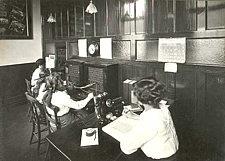 |
|
 |
|
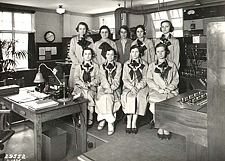 |
| 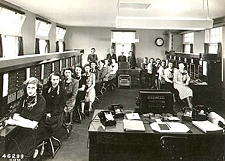 |
|
| Factory Telephone Exhange, 1911 |
|
Factory Telephone Exhange, 1924 |
|
Factory Telephone Exhange, 1936 |
|
Factory Telephone Exhange, 1949 |
|
|
 |
|
 |
|
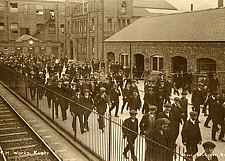 |
|  |
|
| View from North East, c.1940 |
|
Workers' Break, c.1915 |
|
Workers' Break, c.1940 |
|
End of the Workday, c.1940 |
|
|
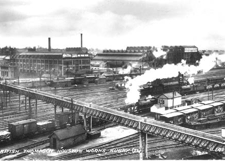 |
|
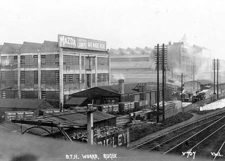 |
|
 |
| 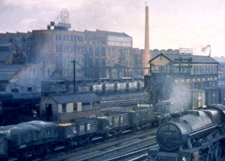 |
|
| Southern Facade, c.1935 |
|
Southern Facade, c.1935 |
|
Southern Facade, c.1935 |
|
Southern Facade, c.1940 |
|
|
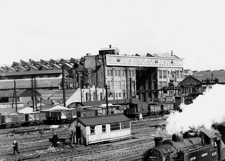 |
|
 |
|
 |
|
 |
|
| Southern Facade, c.1950 |
|
Southern Facade, c.1960 |
|
Southern Facade, c.1960 |
|
Southern Facade, c.1980 |
|
|
 |
|
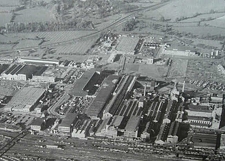 |
|
 |
|
 |
|
| Aerial View from East, 1946 |
|
Aerial View from South, 1963 |
|
Building 52 Research Lab, c.1980 |
|
Building 9 Power House, c.1980 |
|
|
 |
|
 |
|
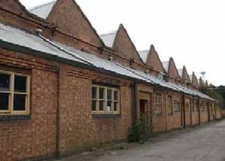 |
|
 |
|
| Building 78, 2007, Ref.4 |
|
Building 78, 2007, Ref.4 |
|
Building 78, 2007, Ref.4 |
|
Building 78, 2007, Ref.4 |
|
|
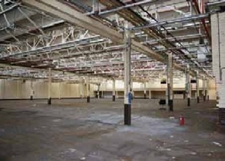 |
|
 |
|
 |
|
| Building 78, 2007, Ref.4 |
|
Building 78, 2007, Ref.4 |
|
GLS Automatic Lines, Building 15, 1935 |
|
Site Layout Plans
|
 |
|
 |
|
 |
|
| Site Layout 1902, Ref.1 |
|
Site Layout 1946, Ref.1 |
|
Site Layout 1960, Ref.3 |
|
|
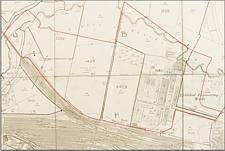 |
|
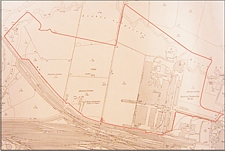 |
|
 |
|
 |
|
| Ordnance Survey Map, 1905, Ref.4 |
|
Ordnance Survey Map, 1914, Ref.4 |
|
Ordnance Survey Map, 1924, Ref.4 |
|
Ordnance Survey Map, 1939, Ref.4 |
|
Examples of Rugby Lamps
|
 |
|
 |
|
 |
|
 |
|
 |
|
 |
| Mazda Vite UV Filament |
|
Blacklight Military |
|
MA/V 400W Mercury |
|
MB/V 80W Mercury |
|
MB/V 80W Mercury |
|
MBM 40W Coal Mine |
|
 |
|
 |
|
|
|
|
|
| >
|
|
| MAF/V 400W Mercury |
|
Fluorescent 5' 80W |
|
|
|
|
|
|
|
|
| 1 |
BTH Reminiscences - Sixty Years of Progress, H.A. Price-Hughes, 1946. |
| 2 |
Anatomy of a Merger : A History of GEC, AEI and English Electric, R.Jones & O.Marriott, Pan Books Ltd, 1970. |
| 3 |
The Establishment and Decline of British Thomson-Houston and Metropolitan-Vickers, D.J. Wilson, 2005. |
| 4 |
Wessex Archaeology Conservation Management - Evaluation of Land and Buildings at Leicester Road, Rugby, 2007. |
|
|
|
|
|